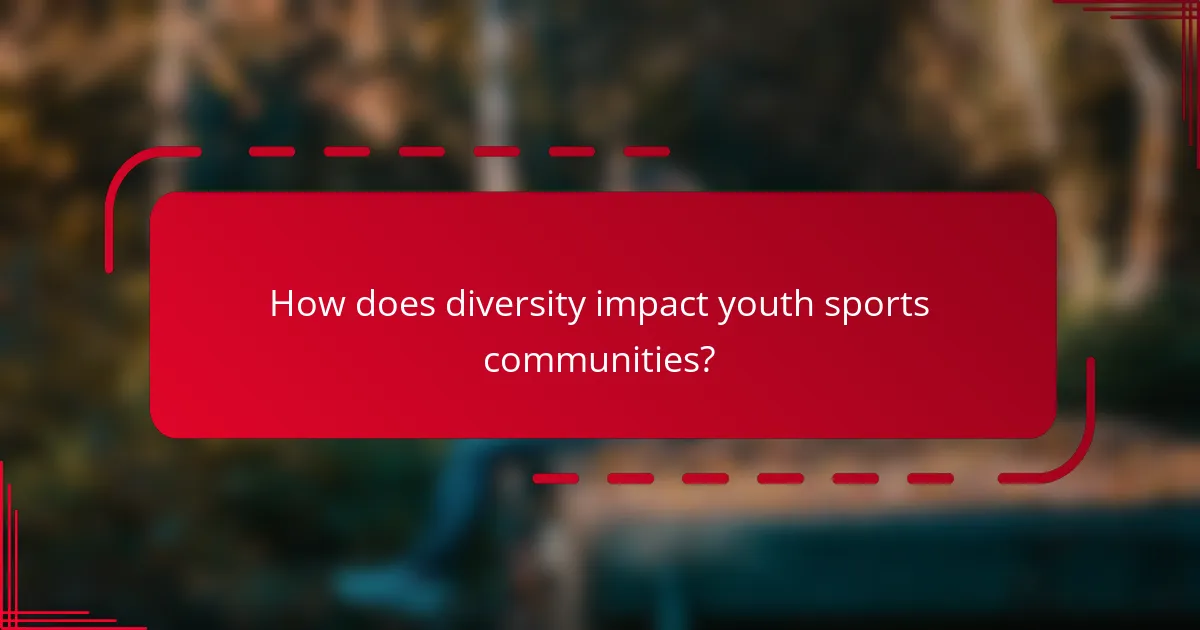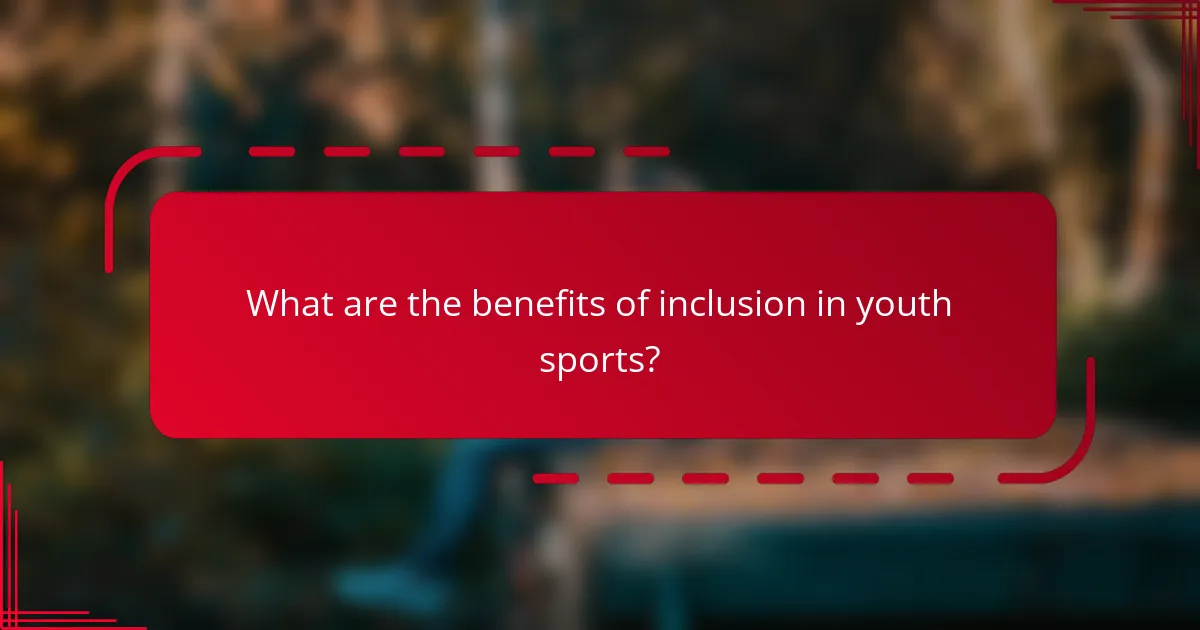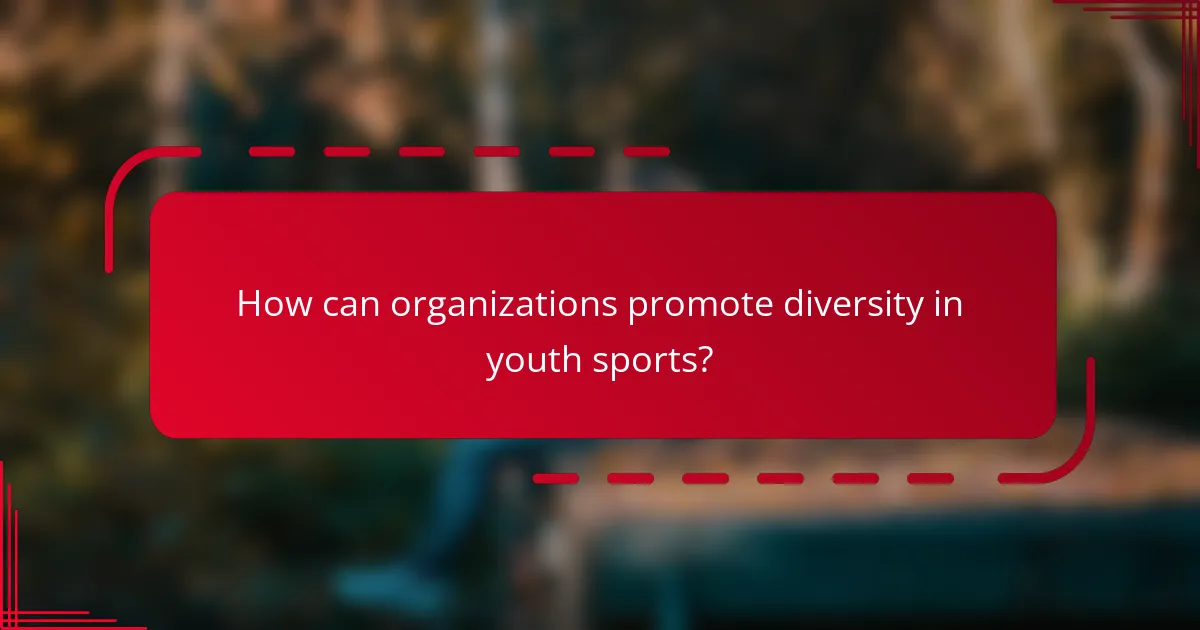Diversity and inclusion play a crucial role in shaping youth sports communities by bringing together individuals from varied backgrounds, enriching the overall experience for all participants. An inclusive environment not only enhances social interactions and teamwork but also fosters a sense of belonging, essential for both personal growth and athletic development.

How does diversity impact youth sports communities?
Diversity significantly enhances youth sports communities by bringing together individuals from various backgrounds, which enriches the overall experience. It fosters a more inclusive environment where all participants feel valued and can contribute to team dynamics.
Enhances team performance
Diverse teams often outperform homogeneous ones due to a wider range of perspectives and problem-solving approaches. This variety can lead to innovative strategies and improved decision-making on the field.
For example, a team that includes players from different cultural backgrounds may develop unique plays that leverage each player’s strengths. Coaches should encourage collaboration among diverse players to maximize performance benefits.
Fosters social connections
Inclusion in youth sports helps build friendships across different cultures and backgrounds, creating a sense of belonging. These social connections can lead to lasting relationships that extend beyond the sports field.
Organizing team-building activities that celebrate diversity, such as cultural exchange days or potlucks, can strengthen these bonds. Encouraging players to share their backgrounds fosters mutual respect and understanding.
Promotes cultural understanding
Participation in diverse youth sports teams exposes players to various cultures, promoting empathy and respect. This exposure helps young athletes develop a broader worldview and appreciation for differences.
Coaches can facilitate discussions about cultural backgrounds and traditions during practice sessions. Incorporating diverse cultural elements into training and events can also enhance players’ understanding and appreciation of one another.

What are the benefits of inclusion in youth sports?
Inclusion in youth sports fosters a welcoming environment that benefits all participants. It enhances social interactions, promotes teamwork, and creates a sense of belonging, which are essential for personal and athletic development.
Improves mental health
Inclusion in youth sports significantly boosts mental health by reducing feelings of isolation and anxiety. When young athletes feel accepted and valued, they are more likely to experience lower stress levels and improved overall well-being.
Programs that prioritize diversity and inclusion often provide supportive networks, helping participants develop coping strategies and resilience. This supportive atmosphere can lead to a more positive outlook on life and increased emotional stability.
Encourages participation
Inclusive youth sports programs attract a broader range of participants, ensuring that everyone, regardless of background or ability, can join in. This diversity not only enriches the experience for all but also encourages more young people to engage in physical activities.
By creating an environment where every child feels welcome, organizations can increase overall participation rates. For example, community leagues that promote inclusivity often see higher enrollment numbers, as families seek out programs that reflect their values.
Builds self-esteem
Participation in inclusive sports helps build self-esteem among young athletes by providing opportunities for achievement and recognition. When children feel accepted and supported, they are more likely to take risks and challenge themselves.
Programs that celebrate diversity often highlight individual strengths, fostering a sense of pride and accomplishment. This positive reinforcement can lead to improved confidence both on and off the field, encouraging youth to pursue their goals with determination.

How can organizations promote diversity in youth sports?
Organizations can promote diversity in youth sports by implementing inclusive practices, fostering education around diversity, and actively engaging with various communities. These approaches create an environment where all young athletes feel welcome and valued, regardless of their background.
Implement inclusive policies
Inclusive policies are vital for ensuring that youth sports organizations welcome participants from diverse backgrounds. This can include non-discrimination clauses, equitable access to resources, and provisions for accommodating different needs, such as language support or adaptive sports options.
Organizations should regularly review their policies to identify barriers that may prevent participation. For example, offering scholarships or reduced fees can help lower economic barriers for families from underrepresented communities.
Provide diversity training
Diversity training equips coaches, staff, and volunteers with the knowledge and skills to create an inclusive environment. Training sessions can cover topics such as cultural competence, unconscious bias, and effective communication strategies with diverse groups.
Regular training sessions can help reinforce the importance of diversity and inclusion, ensuring that all members of the organization understand their role in fostering a welcoming atmosphere. Consider partnering with local experts or organizations specializing in diversity education to enhance training effectiveness.
Engage with diverse communities
Engaging with diverse communities is essential for understanding their unique needs and perspectives. Organizations can host community events, collaborate with local schools, or partner with cultural organizations to build relationships and encourage participation in youth sports.
Active outreach efforts, such as distributing flyers in multiple languages or attending community fairs, can help raise awareness about available programs. Listening to feedback from community members can also guide organizations in making necessary adjustments to better serve diverse populations.

What role do coaches play in fostering inclusion?
Coaches play a crucial role in fostering inclusion within youth sports communities by creating an environment where all participants feel valued and respected. Their actions and attitudes can significantly influence the dynamics of the team and the overall experience for young athletes.
Model inclusive behavior
Coaches should actively demonstrate inclusive behavior by treating all athletes with respect and fairness. This includes recognizing and celebrating the diverse backgrounds of team members, which can help create a sense of belonging. For example, acknowledging different cultural practices during team events can enhance team cohesion.
Additionally, coaches can model inclusive behavior by using language that is supportive and encouraging. Avoiding negative or exclusionary comments fosters a positive atmosphere where all athletes feel empowered to participate fully.
Encourage open communication
Open communication is essential for fostering inclusion in youth sports. Coaches should create an environment where athletes feel comfortable expressing their thoughts and concerns. Regular check-ins or team meetings can facilitate this dialogue, allowing players to share their experiences and suggestions.
Encouraging feedback not only helps coaches understand the needs of their athletes but also empowers young players to advocate for themselves. This practice can lead to improved team dynamics and a more inclusive atmosphere overall.
Adapt coaching styles
Adapting coaching styles to meet the diverse needs of athletes is vital for inclusion. Coaches should be flexible in their approaches, recognizing that different players may respond better to various techniques. For instance, some athletes may thrive with hands-on guidance, while others may prefer a more independent approach.
It’s beneficial for coaches to assess the individual strengths and weaknesses of their team members and adjust their strategies accordingly. This personalized attention not only enhances skill development but also ensures that every athlete feels supported and included in the learning process.

What challenges do youth sports face regarding diversity?
Youth sports encounter significant challenges regarding diversity, including unequal access to resources and resistance to inclusive practices. These obstacles can hinder participation from various demographic groups, limiting the benefits of sports for all youth.
Resource allocation disparities
Resource allocation disparities in youth sports often manifest as unequal funding and facilities, which can disproportionately affect underrepresented communities. For instance, affluent areas may have access to better coaching, equipment, and training facilities, while lower-income regions struggle to provide basic resources.
To address these disparities, organizations can implement equitable funding models that prioritize inclusivity. Establishing partnerships with local businesses or community organizations can help bridge the resource gap, ensuring all youth have access to quality sports programs.
Resistance to change
Resistance to change within youth sports communities can stem from entrenched beliefs and practices that favor traditional norms over diversity. Coaches, parents, and administrators may be hesitant to adopt new approaches that promote inclusivity, fearing disruption to established routines.
To overcome this resistance, it is crucial to engage stakeholders in discussions about the benefits of diversity and inclusion. Providing training and resources that highlight successful inclusive practices can help shift perspectives and encourage a more welcoming environment for all participants.
